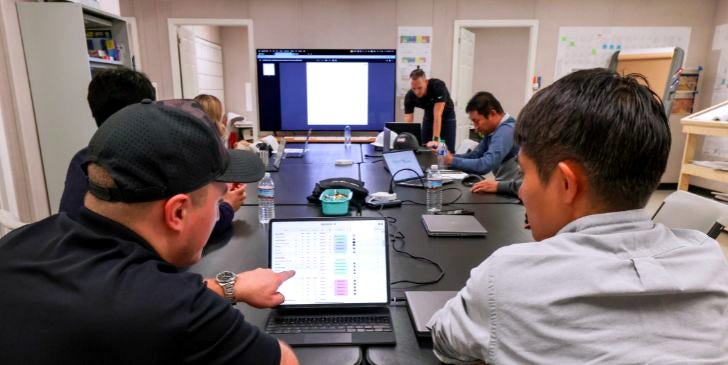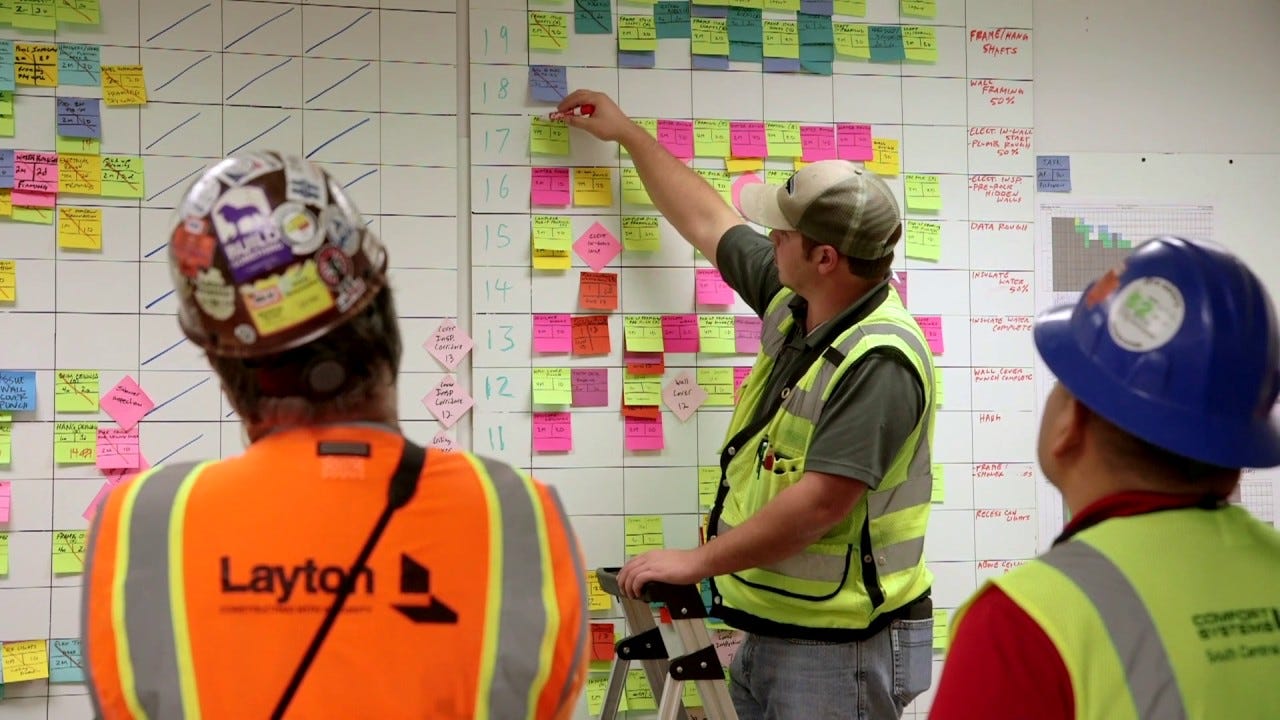Why Your Projects Fall Short—and How to Fix It
Everything you need to know to start using the Last Planner System®.
👋 Hey, Kyle here! Welcome to The Influential Project Manager, a weekly newsletter covering the essentials of successful project leadership.
Today’s Overview:
Your projects don’t rise to the level of your goals; they fall to the level of your systems.
The Last Planner System (LPS) is a framework that completely changed how I manage projects. It’s a collaborative scheduling system that leverages the expertise of trade foremen (last planners) to create reliable, actionable plans.
After investing 1,000+ hours learning LPS—because traditional planning failed me—here’s how you can start applying it today.
📊 Software built for the Last Planner System!
Outbuild is designed for one thing: to make construction scheduling easy, connected, and effective. Here’s why top contractors rely on it
✅ Easy to use: Drag-and-drop features and user-friendly layout mean your team can hit the ground running. No long training needed.
✅ Everyone has access: Let your trade partners, PMs, and PEs all log in, plan their work, and communicate directly.
✅ Seamless integration: Sync your scheduling and field planning effortlessly with Procore. Outbuild keeps all your project workflows in one place.
✅ Real-time reporting and analytics: Track project progress, delays, and resources with powerful analytics that help you make fast, informed decisions.
Outbuild helps you manage projects better, so you can focus on what truly matters.
👉 Book a live demo (30 day free trial included).
📅 Why Your Projects Fall Short—and How to Fix It
Filed under: Lean Tools & Tactics
Let me show you a new way to manage construction projects—because most of what I thought I knew turned out to be wrong:
❌ Schedules tell you who does what by when, but nothing about how.
❌ 90% paperwork, 10% real data, overemphasis on administration.
❌ The Critical Path Method and the Iron Triangle focus on the wrong things.
This leads to a cycle of rush, push, and panic.
But here’s what I’ve learned:
Your projects don’t rise to the level of your goals; they fall to the level of your systems.
Projects are production systems, and your data sets you free.
Speed comes from making work ready, not pushing.
The framework that pulls all these truths together and completely changed how I manage projects is the Last Planner System® (LPS). It incorporates all three of these principles and will make you a stronger, more reliable builder.
After investing 1,000+ hours learning LPS—because traditional planning failed me—here’s how you can start applying it today.
Why Last Planner?
In traditional design and construction projects, the level of follow-through on commitments made is unfortunately low. On average, only 54% of planned work for a given week is completed on time. As a result:
Stakeholders are dissatisfied.
Workers are exposed to higher risks.
Projects are delivered late and over-budget.
LPS was created in the early 1990s to fill a gap in project management—production control.
Here’s the difference:
Project controls set cost and schedule targets and track progress.
Production control makes sure you hit those targets or adjust if things don’t go as planned.
You need both.
Without production control, it’s like driving while only looking in the rear view mirror. Without project controls, it’s like driving with no destination.
LPS combines both project controls and production control, making it a complete system for construction management.
The 5 Elements of the Last Planner System®
The Last Planner System (LPS) breaks down project planning into five essential phases.
Each phase brings unique benefits, and following the process results in higher engagement, shorter durations, and higher profits.
1. Master Planning
The foundation of LPS. This phase sets up the master schedule, establishing major project milestones and goals. These guide the entire project and help track progress.
2. Phase Planning/Scheduling
Teams collaborate to plan each milestone. Using "pull planning," they work backward from key dates, refining the sequence and timing of tasks. Pull planning breaks down the master schedule from milestones into properly sequenced daily tasks.
3. Make Ready Planning
This step ensures teams are ready to work. Planners create a "look-ahead plan" to spot and resolve any roadblocks that could slow progress. Lookahead planning ensures the work is made ready when needed.
4. Weekly Work Planning
Teams commit to tasks for the upcoming week, focusing on teamwork and reliability. Clear, short-term goals keep everyone aligned and on track.
5. Learning
Daily coordination meetings (huddles) and metric analysis (like Percent Plan Complete) allow teams to review progress and make adjustments as needed. The goal is to increase the percentage of tasks completed as planned (PPC).
LPS allows design and construction teams to plan more granularly as the project progresses.
🔑 How to Build Your Last Planner System
If you want to run projects smoothly, it’s time to stop building schedules and start designing a production system.
Schedules are just predictions—they don’t account for variability. What really determines success is the production system. It controls what happens, when it happens, and ensures your team is set up for success.
So, how do you build a production system that works?
It all comes down to getting the right resources (people, materials, tools, equipment, permissions, and information) to your crews at the right time.
Here’s how to do it using The Last Planner System:
Master Plan: This is the foundation. Your master schedule will simulate the entire project. It outlines milestones, total project duration, and who does what by when. It’s your project’s demand roadmap—laying out what needs to happen to meet your goals.
Pull Plans: Pull plans are how we verify sequences in phases and should be done for every milestone. Collaborate with your trade partners to align what the owner wants (demand) with what’s possible (supply). Work backward from each milestone to create a sequence of tasks. These pull plans become your look-ahead schedules.
6 Week Make-ready look ahead plans: The look-ahead schedule is used to make work ready, align specific dates to supply chains, and see and remove roadblocks ahead of time.
Weekly Work Plans: The work plan is a week look-ahead where fine tune coordination is done with trade partners. Commitments are made according to the flow of the project and made ready the week ahead.
Day Plans: Filtered from the weekly work plan, day plans ensure the next day’s work is fully prepared. These are detailed execution plans that ensure crews have everything they need to stay on track.
Crew Plans: At the crew level, specific tasks are broken down to ensure everything happens on time in the right zone. This is the level where precision is key.
Data & Learning: As the trades execute in the field, certain key performance indicators are tracked so the team can see how they are performing.
📐 Last Planner System 101: Rules for Success
I’ve managed many construction projects, and here are the fundamental rules of the Last Planner System (LPS) that helped me succeed:
Rule #1: Keep plans visible and updated.
Hiding plans creates confusion. Everyone needs access to the latest version, so there are no surprises.
Use visual boards to track progress.
Update the plans regularly and notify the team.
Post plans in visible areas like trailers or conference rooms.
Rule #2: Start with milestones.
High-level scheduling sets the foundation. Get started by defining milestones and mapping out key phases to build the framework.
Applying this ensures:
Your team understands critical deadlines.
Tasks are sequenced properly from the start.
Surprises and chaos are minimized.
Rule #3: Decide on a meeting schedule.
Your meeting system keep the project moving forward. Create a consistent format for your look-ahead meetings and work plans.
Set a weekly schedule for your meetings.
Make sure each meeting has a clear agenda.
Rule #4: Detail plans as deadlines approach.
As deadlines get closer, fine-tune the details. Don’t wait until it’s too late.
Mistakes to avoid:
Not updating the team regularly.
Failing to adjust plans as deadlines near.
Missing critical details that surface late.
Rule #5: Collaborate with the doers.
Your team on the ground knows the real challenges. Involve them early in planning.
Set up daily foreman huddles.
Use their input to improve constraint management.
Get them involved in pull planning, look ahead planning, and weekly work plans.
Rule #6: Re-plan when necessary.
Things will change. Don’t stick to outdated plans.
Re-prioritize tasks as needed.
Hold weekly meetings to adjust the plan.
Stay flexible to keep the project on track.
Rule #7: Prioritize reliability over speed.
A reliable workflow means fewer mistakes and smoother operations.
Tips:
Only commit to tasks that are ready.
Identify roadblocks early and remove them.
Focus on doing things right, not just fast.
Rule #8: Remove roadblocks together.
Identifying constraints early prevents delays.
Keep a running list of potential challenges.
Encourage open communication about obstacles.
Work as a team to clear roadblocks before they cause issues.
Rule #9: Make and keep promises.
If you commit to a task, follow through. Build trust with your team by doing what you say.
How to make it work:
Commit to realistic tasks.
Hold yourself accountable.
Communicate openly if something changes.
Rule #10: Only commit to what’s possible.
Set realistic goals and FINISH what you START.
How to apply:
Break down tasks into achievable steps.
Never over-promise on deliverables.
Make sure each task is well-defined and properly sequenced.
Rule #11: Learn from mistakes.
Mistakes happen—what matters is learning from them.
How to apply:
Track your KPIs and review as a team.
Implement changes quickly to avoid delays.
Develop solutions to prevent the same mistake from happening again.
Rule #12: Underload to ensure reliability.
Don’t stretch your team too thin. A little buffer goes a long way.
Plan with a margin for error to reduce stress.
Adjust workloads to avoid overburdening your team.
Focus on quality, not just quantity.
Rule #13: Focus on critical tasks.
Critical tasks drive the project forward. Prioritize them first.
Rule #14: Keep a ready backlog.
A backlog of ready-to-go tasks prevents delays and downtime.
Always have a list of tasks that are prepped and ready.
Ensure your team has a clear idea of what comes next.
Use the backlog to prevent downtime between tasks.
Follow these rules, and I guarantee you’ll see smoother, more predictable projects.
🧠 Why the Last Planner System Works
Everyone has a plan until they get punched in the face.
You know it. I know it. But we keep planning. Why?
As Eisenhower said, “Plans are worthless, but planning is everything.” The value is not in the plan itself but in the process of planning.
Planning forces you to understand the landscape, giving you confidence and options when things go wrong. It also brings teams together and aligns expectations.
When you hit the inevitable roadblock, you can readjust in minutes. Why? Because you have options that you’ve thought through before you started.
No surprises. No drama. Zoom out, reconsider, commit, and continue.
That’s the difference between reacting to manage consequences and proactive project leadership.
Try the Last Planner System and see how your team can enhance workflow and produce better plans—collaboratively.
Happy planning,
Kyle Nitchen
🧰 Kyle’s Toolbox
Speaking of planning…
If you’ve planned to upgrade your project management game this year, I got you:
It's time to replace your Excel template for something smarter—Outbuild Last Planner Software. With Outbuild, you can manage your Master Schedule, Lookahead schedules, weekly work plans, and everything else in real-time, keeping your entire team connected and your projects on track.
I use Outbuild to translate stakeholder expectations into realistic project plans—and it’s made a huge difference.
If you want to learn more about how Outbuild can help implement the Last Planner System and other lean methodologies on your next construction project, feel free to book a demo.

Whenever you're ready, there are 4 ways I can help you:
Upgrade your PM software. Experience the future operating system for construction and real estate development.
Get my full toolbox (free). Access 30+ software and hardware tools I'm using today.
Learn Takt Planning. Elevate your skills as a scheduler, planner, and lean builder with the Takt Planning & Control online course. Use code "Influentialpmtakt" for 30% off.
Advertise in my newsletter. Put your brand in front of 4,000+ construction project managers, leaders, and execs. (Booked out 5 weeks)







